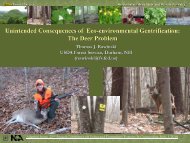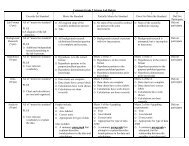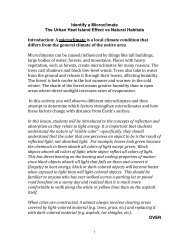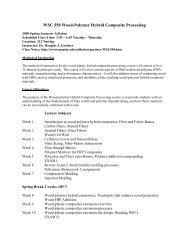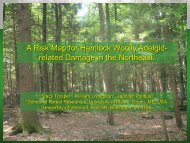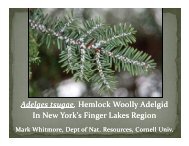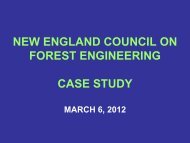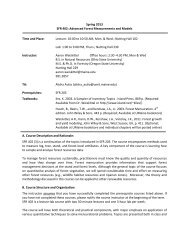Emerald Ash Borer Agrilus planipennis Fairmaire - School of Forest ...
Emerald Ash Borer Agrilus planipennis Fairmaire - School of Forest ...
Emerald Ash Borer Agrilus planipennis Fairmaire - School of Forest ...
You also want an ePaper? Increase the reach of your titles
YUMPU automatically turns print PDFs into web optimized ePapers that Google loves.
The Risks and Benefits <strong>of</strong><br />
Biological Control: A Case<br />
Study <strong>of</strong> the <strong>Emerald</strong> <strong>Ash</strong> <strong>Borer</strong><br />
Juli Gould : USDA-APHIS<br />
Leah Bauer : US <strong>Forest</strong> Service
Mechanical Control<br />
•Expensive<br />
•Usually only cost<br />
effective for small<br />
infestations.
Chemical Control<br />
Can be less expensive than<br />
mechanical control<br />
Consequences include nontarget<br />
mortality,<br />
contamination <strong>of</strong><br />
groundwater, pesticide drift,<br />
pesticide poisoning,<br />
development <strong>of</strong> resistance.<br />
Costly for treating large<br />
areas.<br />
Trunk injections with<br />
Emmamectin Benzoate:<br />
99+% effective
Cultural control…<br />
Regulatory: maintain quarantine<br />
compliance<br />
Outreach: firewood inspections, signage,<br />
web site, early detection and public<br />
awareness, “The Green Menace”, etc.
EAB Potential for Spread<br />
Natural Spread:<br />
Adults are strong fliers<br />
Population can move at<br />
least 750 m in one year<br />
Artificial Spread:<br />
Movement <strong>of</strong> EAB<br />
infested firewood<br />
Movement <strong>of</strong> EAB<br />
infested logs<br />
Movement <strong>of</strong> EAB<br />
infested nursery stock<br />
Difficult to detect<br />
low density<br />
infestations.
Current EAB Distribution
Integrated Approach<br />
SLAM (SLow <strong>Ash</strong> Mortality)<br />
To slow the rate at which EAB<br />
populations build and spread.<br />
Combines sampling, girdling trees to<br />
attract EAB, treating trees with<br />
insecticides or destroying to remove<br />
EAB, removing ash trees to reduce<br />
phloem available as a food source.
Classical Biological<br />
Control<br />
Many exotic invasive pests arrive<br />
without the complement <strong>of</strong> natural<br />
enemies that helps regulate populations<br />
in the native range.<br />
Usually, few natural enemies in the<br />
introduced range attack the new pest.<br />
Classical Biological<br />
Control<br />
The importation <strong>of</strong> a natural enemy from<br />
a foreign country for sustained control <strong>of</strong><br />
a pest also <strong>of</strong> foreign origin.<br />
Successful natural enemies can provide<br />
enduring pest control<br />
Reproduce and disperse without further<br />
human assistance.<br />
Persist after pest population reduced to low<br />
density.
When is classical biological<br />
control used?<br />
When a species is:<br />
not native<br />
established for at least 5 years<br />
causing economic or ecological damage<br />
eradication and control by other means is<br />
not possible<br />
<strong>Agrilus</strong> <strong>planipennis</strong>
Benefits <strong>of</strong> Classical<br />
Biocontrol<br />
Economic<br />
Reduction in crop/forest losses.<br />
Reduction in costs <strong>of</strong> other control<br />
measures.<br />
Environmental<br />
Reduction in pest damage to natural<br />
systems<br />
Reduction in pesticide contamination <strong>of</strong><br />
environment and humans.
Benefits <strong>of</strong> Classical<br />
Biocontrol<br />
Cottony Cushion Scale<br />
almost destroyed the CA<br />
citrus industry in late 1800’s.<br />
Successful control with the<br />
Vedalia beetle and a<br />
parasitoid inspired other<br />
projects.<br />
5000+ introductions against<br />
arthropod pests worldwide<br />
since 1889
Cassava Mealybug<br />
Cassava native to SA but<br />
grown extensively in Africa.<br />
Up to 70% <strong>of</strong> daily energy<br />
intake.<br />
1970: Cassava mealybug<br />
introduced and caused up to<br />
80% crop loss.<br />
Host specific parasitoid<br />
introduced – highly<br />
successful<br />
Benefit : Cost Ratio 500:1
Benefits <strong>of</strong> Classical<br />
Biocontrol <strong>of</strong> Arthropods<br />
16% complete control<br />
42% partial control<br />
Some projects failed because they were too limited<br />
in duration or resources.<br />
Benefit : Cost ratios range from 3:1 to 100 + :1 and<br />
benefits continue to accrue.<br />
In Australia benefit : cost ratios average 10.6:1 for<br />
biocontrol compared with 2.5:1 for pesticides.<br />
Overall benefits from successful projects outweigh<br />
the combined costs <strong>of</strong> unsuccessful projects.
What steps are involved in<br />
biological control?<br />
1. Identify and study biology <strong>of</strong> the invasive pest<br />
2. Survey for native natural enemies<br />
3. Foreign exploration for natural enemies<br />
4. Select potential biocontrol agents<br />
5. Import & study biocontrol agents in quarantine<br />
6. Prepare “release-justification documents”<br />
7. Request & receive permits for field release<br />
8. Select diverse field sites, mass rear, & release<br />
9. Evaluate efficacy & study impact on nontargets
Exploration for Natural<br />
Enemies <strong>of</strong> EAB<br />
Russia<br />
Japan<br />
South Korea<br />
China
Changchun, Jilin Province,<br />
China
Oobius agrili (Encyrtidae)<br />
Female lays a single egg inside EAB egg<br />
Oobius pupa<br />
(dissected from egg)<br />
Parasitoid larva develops<br />
inside EAB egg<br />
Parasite adult chews<br />
exit hole & emerges from egg
Tetrastichus <strong>planipennis</strong>i<br />
Gregarious<br />
endoparasitoid<br />
4-92 per EAB<br />
4 generations per<br />
year<br />
Up to 50%<br />
parasitism
Tianjin City, China
Sclerodermus sp.<br />
Female removes<br />
frass from entrance<br />
to pupal chamber<br />
Female paralyzes<br />
EAB pre-pupa or<br />
pupa and lays 15-20<br />
eggs<br />
70-80% females<br />
wingless<br />
% Parasitism low in<br />
Tianjin
Spathius agrili<br />
Paralyzes the host<br />
Gregarious<br />
ectoparasitoid<br />
1-20 eggs per host
Spathius agrili<br />
3-4 generations per<br />
year.<br />
Up to 90% parasitism<br />
in some stands
Unintended Consequences<br />
<strong>of</strong> Classical Biocontrol<br />
Diluting biodiversity<br />
Deliberately introduced natural enemies<br />
Summary <strong>of</strong> Host Specificity Evidence for<br />
EAB Parasitoids<br />
EAB parasitoids attack significantly more EAB than<br />
non-target insects in laboratory no-choice and<br />
choice tests.<br />
Spathius agrili is attracted to leaves <strong>of</strong> ash but not<br />
to most other plants tested. Must be reared in the<br />
presence <strong>of</strong> EAB adults feeding on ash leaves.<br />
Neither <strong>of</strong> the two larval parasitoids were reared<br />
from any <strong>Agrilus</strong> other than EAB in China.<br />
Spathius native to the USA only sporadically attack<br />
EAB. No native Tetrastichus have been found<br />
ovipositing on EAB. They have not switched hosts.
Benefits <strong>of</strong> EAB Biocontrol<br />
Ecological<br />
Ecosystem functions<br />
Reduce pesticide use<br />
Safety<br />
Trees killed by EAB can lose limbs or topple,<br />
injuring or killing people or damaging<br />
property.
Benefits <strong>of</strong> EAB Biocontrol<br />
Economic<br />
APHIS and State Program Costs<br />
$29.5 million per year average; $206 million total<br />
between 2003 and 2010.<br />
Urban/Suburban Areas<br />
Cost <strong>of</strong> treating, removing, and replacing all 37.9<br />
million ash trees in 25 states is $25 billion.<br />
<strong>Forest</strong>s<br />
Compensatory value <strong>of</strong> 8 billion ash trees in US<br />
timberland potentially infested with EAB is $282<br />
billion.
Risks <strong>of</strong> EAB Biocontrol<br />
Efficacy:<br />
Percent parasitism by Spathius, Oobius, and<br />
Tetrastichus are over 50% in China and all<br />
three species multivoltine.<br />
Sclerodermus: low level <strong>of</strong> attack, females<br />
do not fly, some species in the genus sting<br />
people. Not imported for testing.
Risks <strong>of</strong> EAB Biocontrol<br />
Non-target effects<br />
Low levels <strong>of</strong> attack on native <strong>Agrilus</strong> – EAB<br />
is preferred by all three species.<br />
No risk <strong>of</strong> insects attacking humans or<br />
invading their houses.
Risk Analysis<br />
Risk Analysis takes scientific data, which<br />
is sometimes uncertain, and assigns<br />
societal values to the risks and benefits.<br />
For EAB it was determined that the<br />
benefits outweighed the risks and release<br />
permits were granted in 2007.
Release <strong>of</strong> EAB<br />
Parasitoids<br />
Releases <strong>of</strong> small numbers began in<br />
2007.<br />
In 2009, because <strong>of</strong> advances in rearing<br />
techniques and establishment <strong>of</strong> a mass<br />
rearing facility, we released 6,000<br />
Spathius, 5,000 Oobius, and 16,000<br />
Tetrastichus.<br />
In 2010 over 55,000 Spathius and 80,000<br />
Tetrastichus were released in 7 states.
Parasitoid Overwintering
Conclusions<br />
Exotic invasive species continue to establish in<br />
the United States.<br />
Biocontrol may be the best tool for managing<br />
problematic species.<br />
Biocontrol should be conducted within a<br />
regulatory framework that:<br />
Demonstrates the need (economic,<br />
environmental, lack <strong>of</strong> other options).<br />
Determines feasibility (probability <strong>of</strong><br />
success)<br />
Ensures a low probability <strong>of</strong> non-target<br />
impacts
Spathius from Russia<br />
Possibly more cold<br />
tolerant.<br />
Causes up to 80%<br />
mortality <strong>of</strong> EAB in<br />
Fraxinus pensylvannica<br />
in Russia.<br />
WE NEED NON<br />
TARGET BORERS FOR<br />
HOST SPECIFICITY<br />
TESTING.<br />
Juli.R.Gould@aphis.usda.gov<br />
508-563-9303 ext 220




